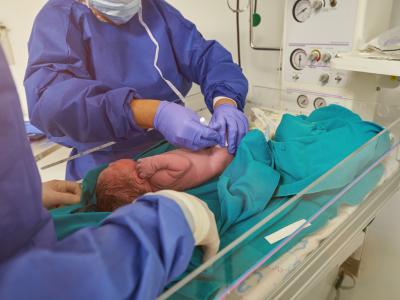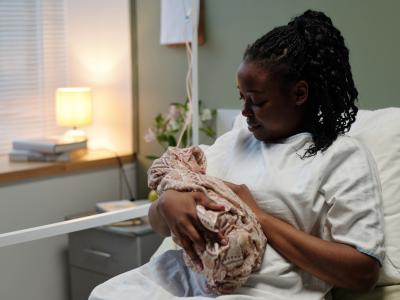Our weekly wrap-up of antimicrobial stewardship & antimicrobial resistance scans
New guidelines say antibiotics not necessary for most toothaches
New guidelines from the American Dental Association (ADA) recommend against using antibiotics for toothaches in most cases.
The guidelines, published in the November issue of the Journal of the American Dental Association, include five recommendation and two good practice statements on management of dental pain associated with pulpal and periapical conditions, including symptomatic irreversible pulpitis, symptomatic apical periodontitis, and pulp necrosis and symptomatic apical periodontitis. Dentists, the third-highest antibiotic prescribers in all US outpatient settings, frequently prescribe antibiotics for these conditions.
The new ADA guidelines, based on a systematic review of literature, recommend against using antibiotics for these conditions in most clinical scenarios, concluding that if there are no signs and symptoms of systemic involvement—such as fever or malaise—and dental treatment is available, antibiotics will provide no substantial improvement in pain intensity and could cause harm. Over-the-counter pain relievers are suggested as alternatives for pain treatment. If fever and malaise are present and immediate dental care is not available, the guidelines suggest prescribing antibiotics.
"Antibiotics are, of course, tremendously important medications," Peter Lockhart, DDS, chair of the expert panel that developed the guideline and a research professor at Carolinas Medical Center-Atrium Health, said in an ADA press release. "However, it's vital that we use them wisely so that they continue to be effective when absolutely needed."
The guidelines note that because patient expectation for antibiotics could present a barrier to implementing these recommendations, the ADA is supplementing them with educational materials for patients on antibiotic stewardship and shared decision-making.
Nov 2019 J Am Dent Assoc guidelines
Oct 25 ADA press release
In roadmap, GARDP spells out antibiotic R&D recommendations
The Global Antibiotic Research & Development Partnership (GARDP) said in a report published yesterday that new antibiotic research and development (R&D) must include developing a practical guidance on responsible manufacturing, environmental standards, best practices for marketing, and data sharing.
The report was based on a workshop held in July that aimed to define priorities and next steps for antibiotic R&D. GARDP sponsored the workshop, which included more than 50 stakeholders, including experts with the Medicines Patent Pool and the World Health Organization.
Participants identified key barriers to antibiotic R&D and suggested that harmonizing regulatory requirements and enabling parallel regulation processes would advance the development of new antimicrobials.
Also recommended was increasing patient access and stewardship by developing a checklist of best practices for access and stewardship of antibiotics, "and the inclusion of these criteria as a requirement for public funding and for registration of a new antibiotics."
The report's authors also recommended that GARDP focus on implementing licensing strategies to support quality manufacturing, early access to antibiotics, affordability, and responsible marketing. The experts also suggest that GARDP collaborate with the WHO and national regulators to ensure optimal regulatory pathways, among other initiatives.
Oct 25 GARDP report
Colistin-resistant Klebsiella infections documented at Indian hospital
Originally published by CIDRAP News Oct 24
A new study in Infection Control and Hospital Epidemiology describes several cases of colistin-resistant Klebsiella pneumoniae infections at a hospital in northern India.
The retrospective study, conducted by researchers from India and the US Centers for Disease Control and Prevention (CDC), focuses on 22 patients at the All India Institute of Medical Sciences in New Delhi who were diagnosed with colistin-resistant K pneumoniae infections from January 2016 through October 2017. The patients were identified as part of an investigation that aimed to determine the extent of colistin-resistance in K pneumonia isolates at the hospital, describe patient characteristics, and characterize transmission dynamics. The high prevalence of carbapenem resistance in gram-negative bacteria in India has led to increasing use of colistin, and recent reports have documented the identification of colistin-resistant K pneumonia in Indian hospitals.
Of the 22 patients, 16 had undergone a surgical procedure prior to the infection, and 7 had a history of exposure to colistin. Ten of the patients died. The 34 isolates collected from the patients represented 4% of all K pneumoniae isolates collected during the study period. Analysis of the isolates found that 100% were multidrug-resistant and 68% were extensively drug resistant; in addition to colistin, all isolates were resistant to carbapenems, extended-spectrum cephalosporins, and penicillin/beta-lactam inhibitors.
Whole-genome sequencing revealed the presence of several carbapenemase genes in the isolates, but no MCR genes. Colistin resistance was attributed to several chromosomal mutations. Sequencing also revealed 8 unique multilocus sequence types (STs), the most common being ST231 (5 isolates), ST11 (4 isolates), and ST14 (4 isolates) — these are well-documented multidrug-resistant K pneumoniaestrains that have caused hospital outbreaks in Europe and Asia.
The authors of the study note that half of the patients had been transferred from other facilities, which suggests colistin-resistant K pneumoniae may be widely distributed in other hospitals in India.
"Action is needed from a broad range of stakeholders, including clinicians, microbiologists, and public health officials, to limit the spread of this critically important MDRO (multidrug-resistant organism)," the authors write.
Oct 18 Infect Control Hosp Epidemiol abstract
Peruvian study finds MDR-TB just as transmissible as drug-sensitive TB
Originally published by CIDRAP News Oct 24
A study conducted in Peru has found that household contacts of patients with multidrug-resistant tuberculosis (MDR-TB) were at higher risk of TB infection than contacts exposed to patients with drug-sensitive TB, and had a similar risk of developing active disease, US and Peruvian researchers reported today in BMJ.
From September 2009 through September 2012, the researchers enrolled 3,339 index patients from health centers in Lima who had microbiologically confirmed TB disease, and 10,160 household contacts. Of those contacts, 6,189 were exposed to drug-sensitive strains of Mycobacterium tuberculosis, 1,659 to strains that were resistant to isoniazid or rifampicin, and 1,541 to MDR-TB strains (resistant to isoniazid and rifampicin). The main outcomes of the study were TB infection and incidence of active disease among household contacts after 12 months of follow-up.
The results showed that contacts of MDR-TB index patients had an 8% (95% confidence interval [CI], 4% to 13%) higher risk of TB infection by the end of follow-up compared with contacts exposed to drug-sensitive TB patients. The relative hazard of incident TB disease did not differ among contacts exposed to MDR-TB compared with those exposed to drug-sensitive TB (adjusted hazard ratio, 1.28; 95% CI, 0.9 to 1.83).
The authors of the study say the results are significant for TB control efforts because they suggest that there is no fitness cost associated with drug resistance in M tuberculosis.
"If M tuberculosis drug resistance exacts no fitness cost, the incidence of drug resistant and multidrug resistant tuberculosis will be expected to fall more slowly than would be expected," they write.
They add, "Our findings provide evidence that invites guideline producers to take action by targeting drug resistant and multidrug resistant tuberculosis, such as the early detection and effective treatment of infection and disease. These guidelines should include the wider deployment of existing tools and the development of diagnostic and therapeutic strategies designed specifically for people already infected with drug resistant tuberculosis."
Oct 24 BMJ study
High-intensity antimicrobial stewardship may top low-intensity
Originally published by CIDRAP News Oct 23
A new study conducted in a 400-bed community hospital in Toronto shows that high-intensity prospective audit and feedback (PAF) was tied to a greater reduction in antimicrobial use than low-intensity interventions. The study appeared yesterday in Infection Control & Hospital Epidemiology.
According to the study authors, PAF is an evaluation of antimicrobial regimens by an infectious diseases or antimicrobial stewardship (ASP) clinician—with recommendations made to the prescriber to optimize antimicrobial use.
The study was conducted at St. Joseph's Health Centre from 2012 to 2016. Before the intervention, ASP pharmacists performed low-intensity PAF, via recommendations made on a per-patient basis to hospital internists. The high-intensity, rounds–based PAF initiative began in 2014 and included twice-weekly ASP rounds on the internal medicine wards from September 2014 through December 2015.
"Implementation of high-intensity PAF was associated with a 19% (adjusted analysis) reduction in overall antibiotic use compared to low-intensity PAF in our community teaching hospital without any changes in patient clinical outcomes," the authors said.
Prescriptions dropped from 483 defined daily doses (DDD) per 1,000 patient days (PD) during the low-intensity phase to 442 DDD/1,000 PD in the high-intensity phase.
Oct 22 Infect Control Hosp Epidemiol study
High antibiotic prescribing levels, provider variability noted in urgent care
Originally published by CIDRAP News Oct 23
An analysis of visits to urgent care clinics that are part of a large healthcare system found high levels of antibiotic prescribing, much of it for respiratory conditions, with provider variability in prescribing that was also high. A team led by researchers from Intermountain Healthcare in Salt Lake City, Utah, reported their findings today in Clinical Infectious Diseases.
Given that urgent care visits are increasing and are known to involve high rates of inappropriate antibiotic prescribing, the group said its goal was to identify patterns within urgent care settings that are part of a large integrated health system.
The retrospective cohort study took place at Intermountain Healthcare's 38 urgent care clinics from August 2017 through June 2019. Of 1.16 million urgent care encounters, antibiotics were prescribed during 34% of visits, with respiratory conditions accounting for 61% all antibiotics that providers prescribed.
Of visits for respiratory conditions, 50% resulted in antibiotic prescriptions. However, levels by provider varied from 3% to 94%. The group also saw similar prescribing variability among providers for respiratory conditions in which antibiotics weren't indicated and in first-line antibiotic selection for sinusitis, otitis media, and pharyngitis.
They said antibiotic prescribing at Intermountain healthcare's urgent care clinics was similar to the 39% national level.
"Collectively, these findings support the importance of integrating antibiotic stewardship principles into UC settings and developing interventions specifically targeting UC [urgent care] settings," the authors write. They added that tier 2 respiratory conditions—including pharyngitis, sinusitis, and otitis media—accounted for more than half of all respiratory conditions, suggesting that stewardship interventions that target those illnesses have the potential for substantial impact by ensuring appropriate diagnosis, using delayed prescriptions for sinusitis and ear infection, and promoting appropriate antibiotic selection.
Oct 23 Clin Infect Dis abstract
WHO issues toolkit for stewardship programs in low-resource countries
Originally published by CIDRAP News Oct 22
The WHO yesterday published a roadmap for implementing antimicrobial stewardship programs in healthcare facilities in low- and middle-income countries (LMICs).
The WHO toolkit provides guidance on the core elements and structures that need to be in place at the national and facility level in low-resource countries to establish and support antimicrobial stewardship, along with detailed recommendations on how to plan, perform, and assess stewardship interventions. It also provides an overview of the core competencies that an antimicrobial stewardship team needs to facilitate more responsible antibiotic prescribing, and the education and training required to develop those competencies.
The aim of the toolkit, according to Hanan Balkhy, MD, the WHO's assistant director-general for antimicrobial resistance (AMR), is to offer practical guidance to LMICs to support objective 4 of the Global Action Plan on AMR—optimizing the use of antimicrobial medicines.
"It is my sincerest hope that this toolkit will be helpful to countries in implementing their national action plans on AMR, in particular in optimizing their use of antibiotics," Balkhy writes in the foreword. "Time is running out, but we still have a window of opportunity to turn the tide on AMR and ensure continued effective treatment of bacterial infections for future generations. Let us act now."
Oct 21 WHO toolkit for stewardship in LMICs
G20 health ministers reaffirm commitment to urgent action on AMR
Originally published by CIDRAP News Oct 22
In a statement issued after their recent meeting in Japan, health officials from 19 countries and the European Union have reaffirmed their commitment to take urgent action to address AMR.
The Okayama Declaration, released following the Oct 19-20 meeting of G20 Health Ministers in Okayama, Japan, contains several commitments to address major health issues, which have been a focus of the group since 2017. In addition to AMR, the document reaffirms commitments to universal health coverage, active and healthy aging, and strengthening health systems against infectious disease outbreaks and other global health threats.
On AMR, the ministers say they will strengthen efforts to fund, implement, monitor, and update national and regional AMR action plans; enhance implementation of measures to provide clean water, sanitation, vaccination, and hygiene to improve infection control; promote antimicrobial stewardship and appropriate access to antimicrobials and diagnostics; encourage countries to strengthen AMR surveillance; and encourage investment in research and development of new antibiotics, diagnostics, and vaccines.
The document also acknowledges the need for a coordinated approach to addressing AMR and universal health coverage in order to achieve the 2030 Agenda for Sustainable Development.
Oct 20 Okayama Declaration
FDA details progress made in veterinary antimicrobial stewardship
Originally published by CIDRAP News Oct 22
Yesterday the US Food and Drug Administration (FDA) made public performance measures for tracking the progress of the Center of Veterinary Medicine's (CVM's) Five-Year Plan for Supporting Antimicrobial Stewardship in Veterinary Settings, the FDA said in an update. The information is contained in FDA-TRACK, which monitors progress on FDA projects.
The CVM 5-year plan contains three goals:
- Align antimicrobial drug product use with the principles of antimicrobial stewardship
- Foster stewardship of antimicrobials in veterinary settings
- Enhance monitoring of AMR and antimicrobial use in animals
The new performance measures pertain to the first goal and include implementing Guidance for Industry #213, which brings 292 medically important antimicrobials under veterinary oversight, defining the duration of use for 70% of medically important antimicrobial drugs used in food animals, assessing antimicrobial risk, and updating the list of medically important antimicrobials.
Performance measures for the other two goals will be made available in the coming year, the FDA said.
Oct 21 FDA update
FDA-TRACK progress report
Electronic advisory plus education tied to lower antibiotic prescribing
Originally published by CIDRAP News Oct 21
A study today in Infection Control & Hospital Epidemiology has determined that an electronic best practice advisory combined with prescriber education was associated with reduced antibiotic prescribing for adults with acute bronchitis.
Wisconsin researchers conducted the quasi-experimental study involving ambulatory adults who had a primary diagnosis of acute bronchitis from 2016 through 2018. The patients sought care at Aurora Health Care facilities in eastern Wisconsin and northeastern Illinois. Aurora implemented an antimicrobial stewardship program involving a passive, prescriber-directed, electronic best-practice advisory coupled with prescriber education in 15 emergency clinics and more than 30 urgent care clinics in December 2016 and at more than 150 ambulatory clinics in September 2017.
The study included 81,975 patients in the pre-intervention period and 89,571 in the post-intervention period. The researchers discovered that antibiotic prescribing rates decreased from 60.8% (49,877 of 81,975 patients) pre-intervention to 51.4% (46,018 of 89,571) post-intervention, or a 9.4-percentage-point drop. The greatest decrease was seen in emergency departments (47.6% to 29.1%; 18.5 percentage points), followed by ambulatory care (58.6% to 45.1%; 13.5) and urgent care clinics (66.9% to 58.0%; 8.9).
The authors write, "This analysis combined with previous studies highlights the necessity of multimodal antimicrobial stewardship interventions in the ambulatory setting." They add, however, "Despite a promising reduction in antibiotic prescribing in this study, prescribing rates remain far above the expected appropriate rates."
Oct 21 Infect Control Hosp Epidemiol abstract
European study shows alarming rise in H pylori resistance
Originally published by CIDRAP News Oct 21
Resistance rates for antibiotics commonly used to treat Helicobacter pylori infection are rising at an alarming rate, according to a study presented today at a gastroenterology meeting in Barcelona.
The study analyzed 1,232 patients with H pylori infections across 18 countries in Europe and found that resistance to clarithromycin rose from 9.9% in 1998 to 21.6% in 2018, while resistance to levofloxacin rose from 14.1% to 16.3% and resistance to metronidazole increased from 33.1% to 39.1%. The countries with the highest rates of primary clarithromycin resistance were Italy (36.9%), Croatia (34.6%), and Greece (30%).
"H. pylori infection is already a complex condition to treat, requiring a combination of medications," lead researcher Francis Megraud, MD, a professor of bacteriology at the University of Bordeaux, said in a press release from United European Gastroenterology (UEG) Week 2019. "With resistance rates to commonly used antibiotics such as clarithromycin increasing at an alarming rate of nearly 1% per year, treatment options for H. pylori will become progressively limited and ineffective if novel treatment strategies remain undeveloped."
H pylori infection causes inflammation of the stomach lining and can lead to peptic ulcers. The bacteria is also associated with lymphoma and gastric cancer. Megraud said that if resistance to current H pylori therapies continues at the current pace, incidence rates of gastric cancer and peptic ulcers could remain high.
The World Health Organization has identified clarithromycin-resistant H pylori as a high priority pathogen for antibiotic research and development.
Oct 21 UEG Week 2019 press release
Study suggest market exclusivity vouchers could be costly
Originally published by CIDRAP News Oct 21
Using transferrable market exclusivity vouchers to incentivize new antibiotic development could end up costing taxpayers billions, according to a paper yesterday in Clinical Infectious Diseases.
Under the Re-Valuing Antimicrobial Products (REVAMP) Act, a bill introduced in Congress in June 2018, manufacturers that gain FDA approval for critically needed, novel antibiotics would receive a 12-month transferrable market exclusivity extension voucher that could be applied to an existing brand-name drug or sold to another manufacturer. The idea was that allowing pharmaceutical companies to extend market exclusivity on high-revenue drugs and forestall competition from generics could provide a financial incentive to develop new antibiotics. Although the legislation did not advance to a full vote, the idea is among the financial "pull" incentives that have been proposed to promote antibiotic development.
To understand the potential economic implications of the REVAMP Act, researchers from Harvard Medical School and Brigham and Women's Hospital identified 10 antibiotics approved by the FDA from 2007 through 2016 that would have qualified for the voucher and matched each antibiotic, according to the rules proposed under the legislation, to the 10 fast-track drugs with the highest revenue facing generic entry within the 4 years following the antibiotic's approval (the bill stipulated that drugs receiving the voucher had to have been given fast-track status by the FDA). They then calculated the per-drug and total societal costs of the vouchers over a decade.
The 10 drugs had a median annual revenue prior to generic entry of $249 million. Accounting for a 75% spending reduction after generic entry, the analysis calculated that the median spending associated with an exclusivity voucher was $187 million, and that total spending associated with a 12-month exclusivity extension for all 10 drugs was $4.5 billion.
The researchers argue that while exclusivity extensions are a popular policy option for lawmakers because they don't require a spending-line item when passed by Congress, their analysis shows that the incentive can be costly from a societal perspective.
"As focus continues to grow on ways to encourage generation of new antibiotics as a complement to other strategies to reduce antimicrobial resistance—such as improved antibiotic stewardship—our results raise important concerns about the overall cost of transferable exclusivity vouchers," they write.
Oct 20 Clin Infect Dis abstract
Study highlights sensitivity of rapid carbapenemase detection test
Originally published by CIDRAP News Oct 21
Swiss researchers report in Clinical Microbiology and Infection that a new rapid carbapenamase detection test is reliable for the screening and detection of carbapenemase-producing organisms (CPOs) and produces quicker results, but that the relatively low specificity of the test may require the use of additional confirmatory methods.
To evaluate the performance of Becton-Dickinson's Phoenix CPO Detect Test, which detects class A, B, and D carbapenemases in gram-negative bacteria and received FDA clearance earlier this year, researchers from the Institute of Microbiology at Lausanne University Hospital performed retrospective and prospective analysis on a collection of 185 molecularly-characterized bacterial isolates and 295 conventional isolates, respectively. The 185 molecularly characterized isolates included 92 CPO and 93 non-CPO strains, and the 295 isolates included 135 with suspected carbapenemase production and 156 without.
In the retrospective study, the CPO test exhibited 92.4% accuracy (95% confidence interval [CI], 87.6 to 95.8), 97.8% sensitivity (95% CI, 92.4 to 99.7), and 87.1% specificity (95%, 78.6 to 83.2) for carbapenemase detection, and provided a classification to class A, B, and D for 81.3% of detected carbapenemases with 94.6% accuracy (95% CI, 86.7 to 98.5).
In the prospective study, the CPO test show 77.8% accuracy (95% CI, 68.8 to 84.5), 100% sensitivity (95% CI, 91.2 to 100), and 67.7% specificity (95% CI, 57.3 to 77.1) on 135 CPO-suspicious isolates and 98.8% accuracy and specificity (95% CI, 95.6 to 99.9) on 160 non-CPO suspicious isolates.
The analysis also found that, compared to routine testing methods, the implementation of the CPO test allowed a mean reduction of 21.3 hours in turnaround time (TAT), 16.8 minutes in hands-on time, and an overall cost reduction of 45%. The researchers suggest the significantly decreased TAT observed with the Phoenix CPO Detect test may have a positive impact on therapeutic and infection control decisions, including antibiotic de-escalation and escalation, as well as costly patient isolation measures.
"Overall, the implementation of the Phoenix CPO Detect test may have a positive impact on laboratory workflows but also on therapeutic and infection control decisions," the authors of the study write.
The authors report grants from Becton-Dickinson during the conduct of the study.
Oct 18 Clin Microbiol Infect study
Study: Antibiotic prescribing rises before some chronic disease diagnoses
Originally published by CIDRAP News Oct 21
A study to examine antibiotic use patterns before and after patients are diagnosed with underlying health conditions found that levels increased before some chronic conditions, like asthma and heart failure, but not others. A team from University College London published its findings today in Clinical Infectious Diseases.
For the study, the investigators looked at a UK primary care database, focusing on adults without earlier comorbidities who were registered from 2008 through 2015. They estimated rates of antibiotic prescribing in the 12 months before and after diagnosis of several health conditions and for controls who didn't have underlying health issues. Conditions included new-onset stroke, coronary heart disease, heart failure, peripheral arterial disease, asthma, chronic kidney diseases, diabetes, or chronic obstructive pulmonary disease (COPD).
Of 1,071,94 patients included in the study, 106,540 (9.9%) were diagnosed with one of the health conditions. For asthma, heart failure, and COPD, antibiotic prescribing rates increased 1.9- to 2.3-fold in the 4 to 9 months that preceded diagnosis. Prescribing then declined to stable levels within 2 months of diagnosis.
However, for diabetes, the trend was less marked. And for those with vascular conditions, prescribing rates increased immediately before diagnosis, remaining 30% to 39% higher than baseline. Among the control group, prescribing rates increased by 17% to 28% in the months before and after doctors' visits.
The authors said antibiotic prescribing appears to increase rapidly before patients are diagnosed as having conditions that have respiratory symptoms, such as COPD, heart failure, and asthma, then drop off afterward. Patterns suggest that respiratory symptoms might be diagnosed as infection and that earlier diagnosis of certain underlying health issues could be a way to reduce unnecessary antibiotic prescribing.
Oct 21 Clin Infect Dis abstract










